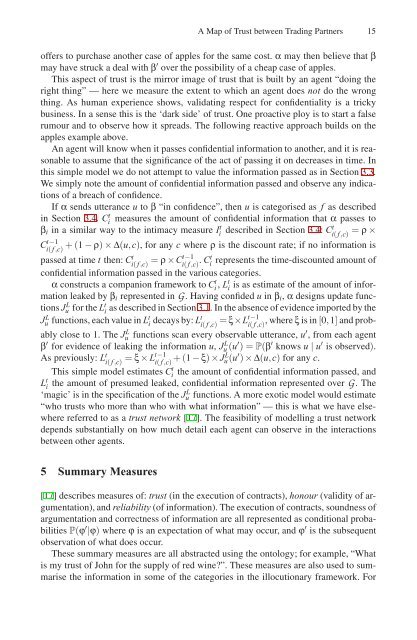Lecture Notes in Computer Science 5185
Lecture Notes in Computer Science 5185
Lecture Notes in Computer Science 5185
Create successful ePaper yourself
Turn your PDF publications into a flip-book with our unique Google optimized e-Paper software.
A Map of Trust between Trad<strong>in</strong>g Partners 15<br />
offers to purchase another case of apples for the same cost. α may then believe that β<br />
may have struck a deal with β ′ over the possibility of a cheap case of apples.<br />
This aspect of trust is the mirror image of trust that is built by an agent “do<strong>in</strong>g the<br />
right th<strong>in</strong>g” — here we measure the extent to which an agent does not do the wrong<br />
th<strong>in</strong>g. As human experience shows, validat<strong>in</strong>g respect for confidentiality is a tricky<br />
bus<strong>in</strong>ess. In a sense this is the ‘dark side’ of trust. One proactive ploy is to start a false<br />
rumour and to observe how it spreads. The follow<strong>in</strong>g reactive approach builds on the<br />
apples example above.<br />
An agent will know when it passes confidential <strong>in</strong>formation to another, and it is reasonable<br />
to assume that the significance of the act of pass<strong>in</strong>g it on decreases <strong>in</strong> time. In<br />
this simple model we do not attempt to value the <strong>in</strong>formation passed as <strong>in</strong> Section 3.3.<br />
We simply note the amount of confidential <strong>in</strong>formation passed and observe any <strong>in</strong>dications<br />
of a breach of confidence.<br />
If α sends utterance u to β “<strong>in</strong> confidence”, then u is categorised as f as described<br />
<strong>in</strong> Section 3.4. Ct i measures the amount of confidential <strong>in</strong>formation that α passes to<br />
βi <strong>in</strong> a similar way to the <strong>in</strong>timacy measure It i described <strong>in</strong> Section 3.4: Ct i( f ,c) = ρ ×<br />
C t−1<br />
i( f ,c) +(1− ρ) × Δ(u,c), foranycwhere ρ is the discount rate; if no <strong>in</strong>formation is<br />
passed at time t then: Ct i( f ,c) = ρ ×Ct−1<br />
i( f ,c) . Ct i represents the time-discounted amount of<br />
confidential <strong>in</strong>formation passed <strong>in</strong> the various categories.<br />
α constructs a companion framework to Ct i , Lti is as estimate of the amount of <strong>in</strong>formation<br />
leaked by βi represented <strong>in</strong> G. Hav<strong>in</strong>g confided u <strong>in</strong> βi, α designs update functions<br />
JL u for the Lt i as described <strong>in</strong> Section 3.1. In the absence of evidence imported by the<br />
JL u functions, each value <strong>in</strong> Lti decays by: Lt i( f ,c) = ξ×Lt−1<br />
i( f ,c) ,whereξis <strong>in</strong> [0,1] and probably<br />
close to 1. The JL u functions scan every observable utterance, u′ , from each agent<br />
β ′ for evidence of leak<strong>in</strong>g the <strong>in</strong>formation u, JL u (u ′ )=P(β ′ knows u | u ′ is observed).<br />
As previously: Lt i( f ,c) = ξ × Lt−1<br />
i( f ,c) +(1− ξ) × JL u (u′ ) × Δ(u,c) for any c.<br />
This simple model estimates Ct i the amount of confidential <strong>in</strong>formation passed, and<br />
Lt i the amount of presumed leaked, confidential <strong>in</strong>formation represented over G. The<br />
‘magic’ is <strong>in</strong> the specification of the JL u functions. A more exotic model would estimate<br />
“who trusts who more than who with what <strong>in</strong>formation” — this is what we have elsewhere<br />
referred to as a trust network [17]. The feasibility of modell<strong>in</strong>g a trust network<br />
depends substantially on how much detail each agent can observe <strong>in</strong> the <strong>in</strong>teractions<br />
between other agents.<br />
5 Summary Measures<br />
[17] describes measures of: trust (<strong>in</strong> the execution of contracts), honour (validity of argumentation),<br />
and reliability (of <strong>in</strong>formation). The execution of contracts, soundness of<br />
argumentation and correctness of <strong>in</strong>formation are all represented as conditional probabilities<br />
P(ϕ ′ |ϕ) where ϕ is an expectation of what may occur, and ϕ ′ is the subsequent<br />
observation of what does occur.<br />
These summary measures are all abstracted us<strong>in</strong>g the ontology; for example, “What<br />
is my trust of John for the supply of red w<strong>in</strong>e?”. These measures are also used to summarise<br />
the <strong>in</strong>formation <strong>in</strong> some of the categories <strong>in</strong> the illocutionary framework. For

















